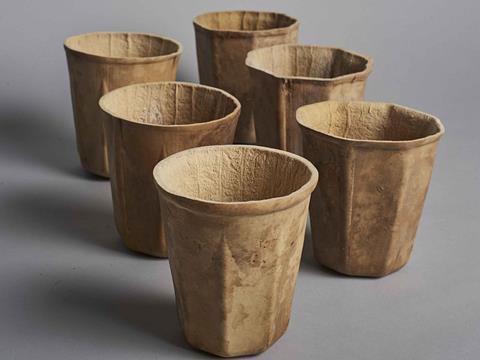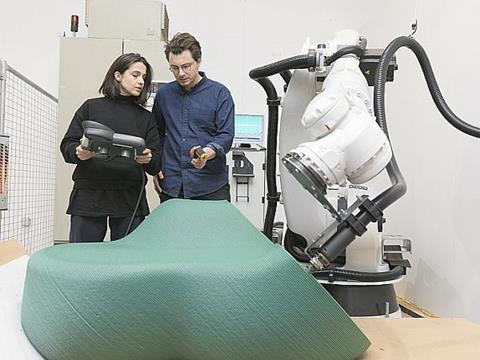
3D printing has been a buzzword for many years, with exciting developments cropping up in many sectors, including medicine, where the first 3D printed heart recently made headlines, construction and automotive.
But what about the packaging industry? Elisabeth Skoda examines three very different 3D print applications in the industry – ranging from reverse engineering more durable parts for packaging machines, creating more sustainable coffee cups and enabling creative uses for packaging waste.
Reverse engineering against wear and tear
A sweets producer in the Netherlands uses additive manufacturing to replace fast-wearing machine parts more efficiently. The Chocolate Factory in Rotterdam faced the problem that high-speed applications in the chocolate packaging process resulted in high wear on individual parts and was looking for solutions to make part replacement easier and faster. How could 3D printing reduce machine damage, downtime and material costs?
The Chocolate Factory packages a wide range of chocolate products. The company’s complex packaging machines rely on the smooth operation of a simple, yet crucial, hook-shaped metal part that lifts wrapped chocolate bars onto a conveyer belt. Due to varying product sizes, the machines require regular adjustments, posing two challenges. First, if the hook-shaped part is fed into the machine incorrectly, it jams and requires immediate replacement. Second, the constant need for human intervention and manoeuvring of metal parts results in damage to the machine.
In cooperation with Visual First, a 3D model specialist, the Chocolate Factory found a new solution that revolutionised the process. Since the machine was already older, there was no existing 3D model, so the project started with the digital production of the part through reverse engineering, i.e. the construction of a 3D model of an existing part.
"The new 3D model allowed us to make test prints on our Leapfrog 3D printer. The first two tests were performed with ColorFabb's XT and HT materials, two strong, rugged plastics. They are very well suited for other applications, but for this machine the material flexibility was too high, and the strength needed to replace the metal was too low," explains Visual First's Carl van de Rijzen.
"We came into contact with 3D printing expert Stratasys by working with the DSV 3D Printing Exploration Lab to find a firmer material. They proposed their new Nylon 12CF material, a thermoplastic filled with carbon fibres. Stratasys sent us a print of the component, which they had produced at their site in Germany on the Stratasys Fortus 450mc 3D printer. The final 3D printed part was just right for The Chocolate Factory. The material feels incredibly hard and stiff, it was impossible to bend, and it passed a test with four pallets of chocolate bars without a hitch."
Increased efficiencies
This solution achieves a 60 per cent saving on the part alone. Unlike a metal spare part, a 3D printed part does not damage the machine if it breaks. Machine downtime is also shorter, as the part is now delivered within a week, compared to a delivery time of one month for the conventional part. This lead time can be further reduced if a 3D printer is available on site.
"We plan to continue working with DSV and Stratasys to further optimise printing," says a spokesperson for The Chocolate Factory. “We want to use even more 3D-printed parts, not only as spare parts, but also for tools for time-consuming processes such as packaging custom products. The possibilities of this technology are enormous."
“Stratasys sees a great future in 3D printed production parts and spare parts for industrial machinery in general and especially for packaging machines”, adds Nadav Sella, head of the company’s Emerging Solutions business unit.
“Those machines require relatively high customisations due to the large variety of products that are packaged. In many cases, the use of 3D printing can not only save time and cost in the manufacturing process of those machines but can also make them more efficient by reducing weight, simplifying design and increasing functionality.”
Custom moulds

Coffee to go continues to enjoy increasing popularity, but it comes at a price. Single-use cups that are carelessly thrown away instead of being recycled have become a very visible problem. Cup recycling schemes or reusable cups offer a solution, but consumer convenience (also known as laziness), often wins - consumers are not always willing to look for a suitable recycling bin, or to take their own cup with them, or simply forget about it.
Brooklyn-based design agency CRÈME has turned to 3D printing and pumpkins to find an unusual alternative to traditional coffee mugs, taking advantage of the unique properties of this particular vegetable. Pumpkins are fast-growing plants with a strong outer skin and fibrous flesh. When dried, they are hard enough to absorb liquids without softening.
Jun Aizaki, the director at CRÈME, was inspired by the Japanese practice of cultivating square watermelons to make them stackable and developed the biodegradable HyO cup - a coffee to go cup made from dried pumpkins. He then faced the challenge of how to shape a pumpkin so that you could drink coffee from it and for it to stand upright when it is put down.
The answer could be found with a 3D printer. Once the designers decided on the desired cup shape, they used a 3D printer to create a hollow shape into which the pumpkin could grow.
The 3D mould is custom printed and reusable. It allows us to create the exact shape and size we desire as well as maintain a standard, uniformity. It features elements such as a lip on the flask as well as details on the cups to make them stackable, says Tania Kaufmann, business manager at CRÈME.
"Thanks to 3D printing, shapes can be designed so that the growth of these fruits can be brought into any shape - from cups to bottles to vases. When the fruits are large enough to fill the mould, they are simply cut to size. After use, they can then be thrown onto the compost heap. We experimented with several different prototypes and printed the first versions on our office 3D printer. We are currently working on scaling up and having the next round of moulds manufactured."
The process is currently still time-consuming, but Jun Aizaki is convinced that accelerated drying and intensive cultivation can make the process much more efficient.
Creative use of packaging waste

If packaging waste cannot be avoided, the question arises, what to do with it? In addition to the standard recycling programmes, there are also various initiatives to process difficult to recycle plastic packaging waste, for example into flower pots and park benches. Print Your City! is an ongoing research project that uses 3D printing to deliver something a bit more exciting than just a humble bench.
Rotterdam-based design studio The New Raw, which works towards closing material cycles and strengthening local production using an open and scale-less approach that is based on material research, digital design and fabrication, has started to work on the Print Your City! project to use plastic waste to produce 3D-printed street furniture. The first result was the XXX Bench, a creatively shaped, 3D-printed piece of furniture for the city of Amsterdam, created in 2016.
The project was continued in Thessaloniki in Greece. As part of the "Zero Waste Future Programme" in collaboration with Coca-Cola, citizens can actively participate in the recycling process in a special laboratory, the Zero Waste Lab, and design street furniture directly on site.
“The Zero Waste Lab features its own in-house recycling plant that can process PP, PE and PET. Visitors have the opportunity to experience first-hand how recycling works and thus gain a direct connection to the process,” explains Foteini Setaki, co-founder of The New Raw.
The New Raw has developed the 3D printing process itself. "We use a KUKA robot arm connected to an extruder with a heated hose. We developed the connection ourselves to enable printing of more complex shapes tailored to our particular needs. We use different nozzle sizes (from 2 mm to 8 mm) to enable different applications," says Ms Setaki.
The first prototypes for Thessaloniki were printed in the summer of 2018. The 3D printed street furniture boasts integrated additional functions. Each object can be equipped with a bicycle rack or a mini gym, a pot for a tree or even a dog bowl or a bookshelf.
Ms Setaki sees great potential for the project also in other cities.
"It's great to be able continue our project in Thessaloniki on a larger scale and see how our furniture works outdoors and responds to UV light, for example, and we hope to be able to roll out the project in other cities in the future."
















